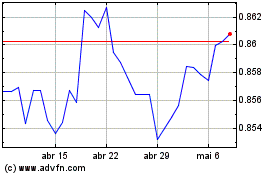Japan GDP Shrinks More Than Estimated In Q2
08 Setembro 2020 - 1:42AM
RTTF2
Japan's economy contracted more than initially estimated in the
second quarter, largely due to a sharp downward revision in capital
investment, second estimates from the Cabinet Office showed
Tuesday.
Due to the restrictions imposed to contain the coronavirus
spread, gross domestic product shrank by a record 7.9 percent
sequentially instead of the 7.8 percent fall estimated
initially.
On an annualized basis, GDP plunged 28.1 percent in the second
quarter compared to the 27.8 percent decline estimated on August
17. The quarterly decline in capital investment was revised to 4.7
percent from 1.5 percent in the second quarter. Government
consumption decreased 0.6 percent, which was more severe than the
prior estimate of a 0.3 percent fall.
Meanwhile, private consumption dropped 7.9 percent, which was
slower than the 8.2 percent decrease estimated previously. The
declines in exports and imports were confirmed at 18.5 percent and
0.5 percent, respectively.
Separate data from the Ministry of Internal Affairs and
Communications showed household spending declined 7.6 percent on a
yearly basis in July. At the same time, household income advanced
9.2 percent from last year.
According to the Ministry of Health, Labor and Welfare, labor
cash earnings declined for the fourth straight month in July.
Average cash earnings fell 1.3 percent after easing 2 percent in
June.
Overtime pay declined sharply by 16.6 percent, while scheduled
wages gained 0.3 percent in July.
Tom Learmouth, an economist at Capital Economics, said wage
growth improved in July and household incomes are likely to rebound
further as more workers who lost their jobs during the state of
emergency find employment again.
However, with far fewer workers on furlough and employment now
starting to gradually recover, the big hit to household incomes is
probably behind us, the economist noted.
Elsewhere, the Bank of Japan reported that bank lending growth
improved to 6.7 percent in August from 6.4 percent in July. Lending
by major banks climbed 8 percent and that by Shinkin banks grew 7.3
percent.
The current surplus fell 27.4 percent to JPY 1.47 trillion in
July largely due to fall in primary income, the Finance Ministry
reported Tuesday.
Euro vs Sterling (FX:EURGBP)
Gráfico Histórico de Câmbio
De Mar 2024 até Abr 2024

Euro vs Sterling (FX:EURGBP)
Gráfico Histórico de Câmbio
De Abr 2023 até Abr 2024
